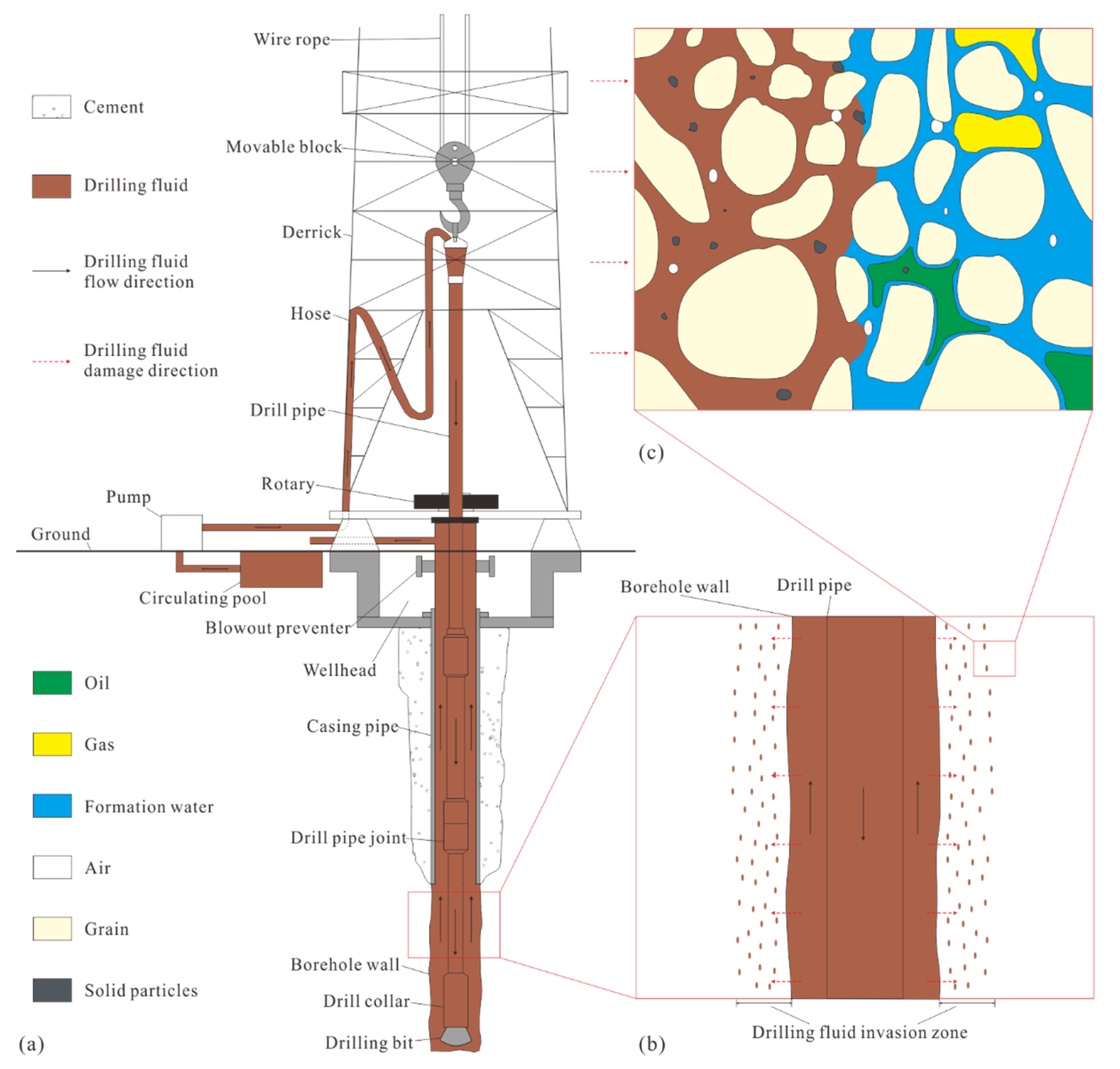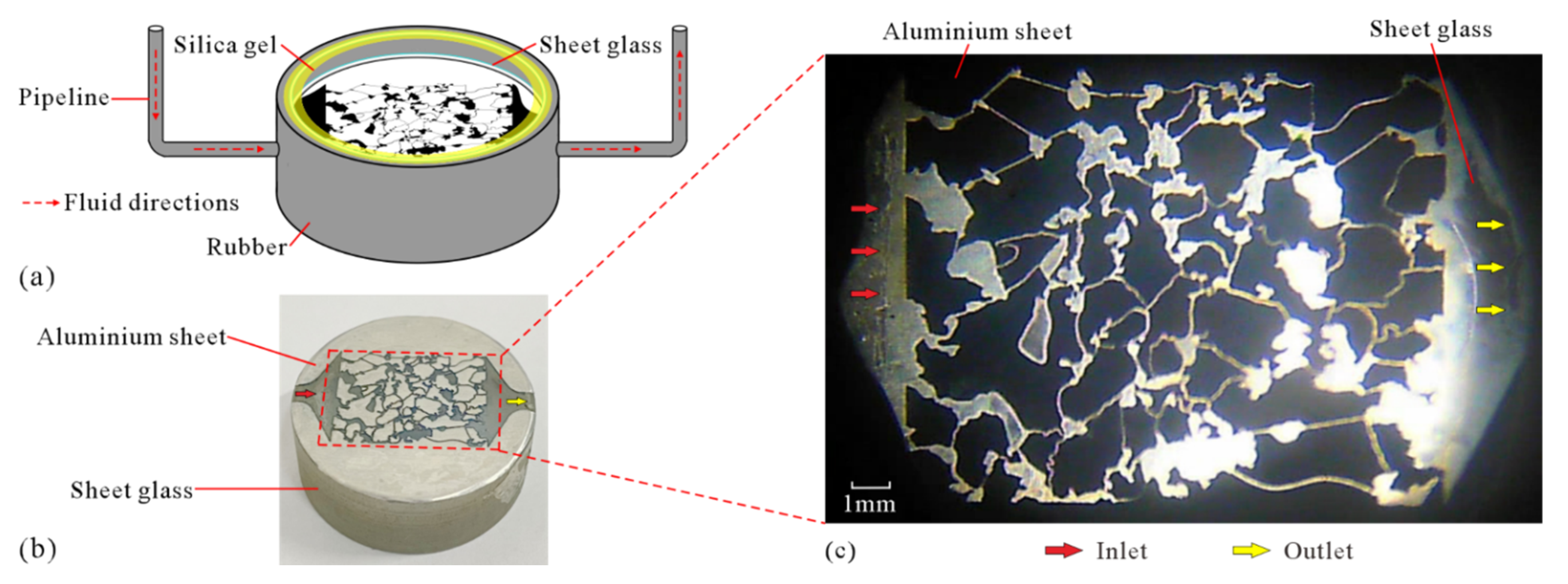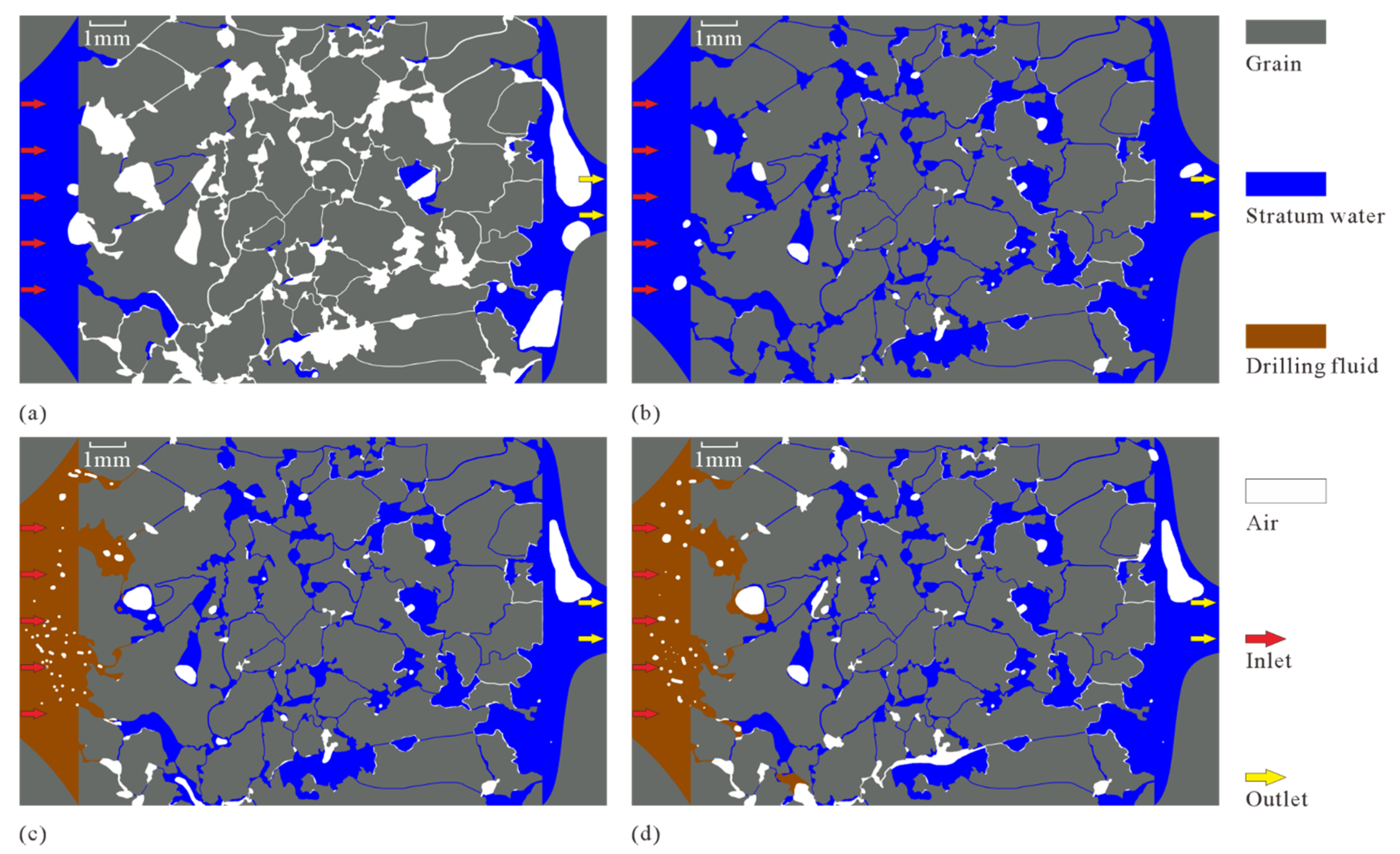An Experiment-Based Study of Formation Damage Using a Microetching Model Displacement Method
Abstract
:1. Introduction
2. Experiments
2.1. Micromodel Fabrication
2.2. Drilling Fluid Displacement
2.3. Permeability Measurement and SEM Observations
3. Geological Setting and Samples
4. Results and Discussion
5. Conclusions
Author Contributions
Funding
Institutional Review Board Statement
Informed Consent Statement
Conflicts of Interest
References
- Ma, T.; Chen, P.; Zhao, J. Overview on vertical and directional drilling technologies for the exploration and exploitation of deep petroleum resources. Geomech. Geophys. Geo-Energy Geo-Resour. 2016, 4, 365–395. [Google Scholar] [CrossRef] [Green Version]
- He, S.; Liang, L.; Zeng, Y.; Ding, Y.; Lin, Y.; Liu, X. The influence of water-based drilling fluid on mechanical property of shale and the wellbore stability. Petroleum 2016, 2, 61–66. [Google Scholar] [CrossRef] [Green Version]
- Lavrov, A. Lost circulation in primary well cementing. Energy Procedia 2017, 114, 5182–5192. [Google Scholar] [CrossRef]
- Katende, A.; Segar, B.; Ismail, I.; Sagala, F.; Saadiah, H.H.A.R.; Samsuri, A. The effect of drill–pipe rotation on improving hole cleaning using polypropylene beads in water-based mud at different hole angles. J. Pet. Explor. Prod. Technol. 2020, 3, 1253–1262. [Google Scholar] [CrossRef] [Green Version]
- Fjelde, I. Formation damages caused by emulsions during drilling with emulsified drilling fluids. SPE Complet. S 2009, 2, 222–228. [Google Scholar] [CrossRef]
- Yang, X.; Meng, Y.; Shi, X.; Li, G. Influence of porosity and permeability heterogeneity on liquid invasion in tight gas reservoirs. J. Nat. Gas Sci. Eng. 2017, 37, 169–177. [Google Scholar] [CrossRef]
- Katende, A.; Lu, Y.; Bunger, A.; Radonjic, M. Experimental quantification of the effect of oil based drilling fluid contamination on properties of wellbore cement. J. Nat. Gas Sci. Eng. 2020, 79, 103328. [Google Scholar] [CrossRef]
- Zhang, L.; Zhou, F.; Zhang, S.; Li, Z.; Wang, J.; Wang, Y. Evaluation of permeability damage caused by drilling and fracturing fluids in tight low permeability sandstone reservoirs. J. Pet. Sci. Eng. 2019, 175, 1122–1135. [Google Scholar] [CrossRef]
- Wang, C.; Wang, Y.; Kuru, E.; Chen, E.; Xiao, F.; Chen, Z.; Yang, D. A new low-damage drilling fluid for sandstone reservoirs with low-permeability: Formulation, evaluation, and applications. J. Energy Resour. Technol. 2021, 5, 053004. [Google Scholar] [CrossRef]
- Wang, Z.; Qiu, Y.; Guo, P.; Du, J.; Liu, H.; Hu, Y.; Zeng, F. Experimental investigation of the damage mechanisms of drilling mud in fractured tight gas reservoir. J. Energy Resour. Technol. 2019, 9, 092907. [Google Scholar] [CrossRef]
- Wu, F.; Wen, Z.; Yao, C.; Wang, X.; Xi, Y.; Cong, L. Numerical simulation of the influence of pore structure on resistivity, Formation factor and cementation index in tight sandstone. Acta Geol. Sin. 2020, 2, 290–304. [Google Scholar] [CrossRef]
- Ezeakacha, C.; Salehi, S.; Hayatdavoudi, A. Experimental Study of Drilling Fluid’s Filtration and Mud Cake Evolution in Sandstone Formations. J. Energy Resour. Technol. 2017, 139, 022912. [Google Scholar] [CrossRef]
- Dong, S.; Zeng, L.; Xu, C.; Dowd, P.; Gao, Z.; Mao, Z.; Wang, A. A novel method for extracting information on pores from cast thin-section images. Comput. Geosci. 2019, 130, 69–83. [Google Scholar] [CrossRef]
- Zhou, L.; Qin, M.; Xiao, D.; Leng, C.; Li, H.; Xie, S.; Carranza, E.J.M.; Zhang, J. Multi-scaling properties of 2D reservoir micro-pore heterogeneity based on digital casting thin-section images. Nat. Resour. Res. 2021, 1, 359–370. [Google Scholar] [CrossRef]
- Yao, R.; Jiang, G.; Li, W.; Deng, T.; Zhang, H. Effect of water-based drilling fluid components on filter cake structure. Powder Technol. 2014, 262, 51–61. [Google Scholar] [CrossRef]
- Huang, X.; Sun, J.; Huang, Y.; Yan, B.; Dong, X.; Liu, F.; Wang, R. Laponite: A promising nanomaterial to formulate high-performance water-based drilling fluids. Pet. Sci. 2021, 18, 579–590. [Google Scholar] [CrossRef]
- Bageri, B.S.; Adebayo, A.R.; Al Jaberi, J.; Patil, S.; Salin, R.B. Evaluating drilling fluid infiltration in porous media–comparing NMR, gravimetric, and X-ray CT scan methods. J. Pet. Sci. Eng. 2021, 198, 108242. [Google Scholar] [CrossRef]
- Sun, J.; Cai, J.; Feng, P.; Sun, F.; Li, J.; Lu, J.; Yan, W. Study on nuclear magnetic resonance logging T2 spectrum shape correction of sandstone reservoirs in oil-based mud wells. Molecules 2021, 19, 6082. [Google Scholar] [CrossRef]
- Andhumoudine, A.B.; Nie, X.; Zhou, Q.; Yu, J.; Kane, O.I.; Jin, L.; Djaroun, R.R. Investigation of coal elastic properties based on digital core technology and finite element method. Adv. Geo-Energy Res. 2021, 1, 53–63. [Google Scholar] [CrossRef]
- Elkatatny, S.; Mahmoud, M.; Nasr-El-Din, H.A. Filter cake properties of water-based drilling fluids under static and dynamic conditions using computed tomography scan. J. Energy Resour. Technol. 2013, 4, 042201. [Google Scholar] [CrossRef]
- Luo, H.; Wang, Z.; Sun, Y.; Jiang, H. Study of drilling fluid system of resisting the high temperature of 220 degrees. Adv. Mater. Res. 2013, 753–755, 130–133. [Google Scholar] [CrossRef]
- Shan, W.; Tao, S.; Fu, F.; Yue, W.; Zhao, Z. Research on the drilling fluid technology for high temperature over 240 °C. Procedia Eng. 2014, 73, 218–229. [Google Scholar] [CrossRef] [Green Version]
- Wang, P.; Chu, W.; Li, W.; Tan, Y.; Liu, F.; Wang, M.; Qi, J.; Lin, J.; Zhang, F.; Wang, Z.; et al. Three-dimensional laser printing of macro-scale glass objects at a micro-scale resolution. Micromachines 2019, 9, 565. [Google Scholar] [CrossRef] [PubMed] [Green Version]
- Owusu-Ansah, E.; Dalton, C. Fabrication of a 3D multi-depth reservoir micromodel in borosilicate glass using femtosecond laser material processing. Micromachines 2020, 11, 1082. [Google Scholar] [CrossRef]
- Kamai, H.; Xu, Y. Fabrication of ultranarrow nanochannels with ultrasmall nanocomponents in glass substrates. Micromachines 2021, 7, 775. [Google Scholar] [CrossRef]
- Bu, M.; Melvin, T.; Ensell, G.J.; Wilkinson, J.S.; Evans, A.G. A new masking technology for deep glass etching and its microfluidic application. Sens. Actuators A Phys. 2004, 2–3, 476–482. [Google Scholar] [CrossRef]
- Xie, H.; Zheng, Y.; Fan, Y.; Fu, X.; Yang, H. A novel restricted-flow etching method for glass. J. Zhejiang Univ.-Sci. A 2009, 11, 1601–1608. [Google Scholar] [CrossRef]
- Karadimitriou, N.K.; Hassanizadeh, S.M. A review of micromodels and their use in two-phase flow studies. Vadose Zone J. 2012, 3, vzj2011.0072. [Google Scholar] [CrossRef]
- Buchgraber, M.; Al-Dossary, M.; Ross, C.M.; Kovscek, A.R. Creation of a dual-porosity micromodel for pore-level visualization of multiphase flow. J. Pet. Sci. Eng. 2012, 86–87, 27–38. [Google Scholar] [CrossRef]
- Song, W.; de Haas, T.W.; Fadaei, H.; Sinton, D. Chip-off-the-old-rock: The study of reservoir-relevant geological processes with real-rock micromodels. Lab A Chip 2014, 22, 4382–4390. [Google Scholar] [CrossRef]
- Martel, R.; Portois, C.; Robert, T.; Uyeda, M. Etched glass micromodel for laboratory simulation of NAPL recovery mechanisms by surfactant solutions in fractured rock. J. Contam. Hydrol. 2019, 227, 103550. [Google Scholar] [CrossRef] [PubMed]
- Zhang, Y.; Zhou, C.; Qu, C.; Wei, M.; He, X.; Bai, B. Fabrication and verification of a glass-silicon-glass micro-/nanofluidic model for investigating multi-phase flow in shale-like unconventional dual-porosity tight porous media. Lab A Chip 2019, 24, 4071–4082. [Google Scholar] [CrossRef] [PubMed]
- Weszka, J.S.; Rosenfeld, A. Threshold evaluation techniques. IEEE Trans. Syst. Man Cybern. 1978, 8, 622–629. [Google Scholar] [CrossRef]
- Dobrin, B.P.; Viero, T.J.; Gabbouj, M. Fast watershed algorithms: Analysis and extensions. Int. Symp. Electron. Imaging: Sci. Technol. 1994, 2180, 209–220. [Google Scholar] [CrossRef]
- Shiozaki, A. Edge extraction using entropy operator. Comput. Vis. Graph. Image Process. 1986, 1, 1–9. [Google Scholar] [CrossRef]
- Shi, L.; Zhu, S.; Guo, Z.; Zhao, W.; Xue, X.; Wang, X.; Ye, Z. Experimental study on the effect of polymer injection timing on oil displacement in porous media. Processes 2020, 1, 93. [Google Scholar] [CrossRef] [Green Version]
- Wu, F.; Yao, C.; Cong, L.; Xi, Y. Pore-scale gas–water flow in rock: Visualization experiment and simulation. Open Geosci. 2020, 1, 532–546. [Google Scholar] [CrossRef]
- Ji, Y.; Hou, J.; Zhao, E.; Liu, C.; Guo, T.; Liu, Y.; Wei, B.; Bai, Y. Pore-scale study on methane hydrate formation and dissociation in a heterogeneous micromodel. J. Nat. Gas Sci. Eng. 2021, 95, 104230. [Google Scholar] [CrossRef]
- Wang, S.; Shi, L.; Ye, Z.; Wang, Y.; Liu, C.; Xue, X. Microscopic experimental study on the sweep and displacement efficiencies in heterogeneous heavy oil reservoirs. Energy Rep. 2021, 7, 1627–1635. [Google Scholar] [CrossRef]
- Darcy, H. Les Fontaines Publiques de la Ville de Dijon; Libraire de Corps Impéiaux des Pontset Chaussées et des Mines: Paris, France, 1856; pp. 590–594. [Google Scholar]
- Ping, H.; Chen, H.; Zhai, P.; Zhu, J.; Xiong, W.; Kong, L.; Gong, S.; Vergara, T.J.; George, S.C. Evidence for deeply buried, oil-prone source rocks in the Baiyun depression, Pearl River Mouth Basin, northern South China Sea. AAPG Bull. 2021, 4, 749–783. [Google Scholar] [CrossRef]
- Zhang, M.; Lin, C.; Jiang, Z.; Li, H.; Zhang, Z.; Tian, H.; Zhang, B.; Liu, H.; Shu, L. Depositional styles of deltaic systems from the inner shelf to shelf edge and their controlling processes: A case study from the Upper Oligocene to Lower Miocene in the Pearl River Mouth Basin. Sediment. Geol. 2021, 423, 105970. [Google Scholar] [CrossRef]
- Peng, J.; Pang, X.; Shi, H.; Peng, H.; Xiao, S. Hydrocarbon-generation potential of upper Eocene Enping Formation mudstones in the Huilu area, northern Pearl River Mouth Basin, South China Sea. AAPG Bull. 2018, 7, 1323–1342. [Google Scholar] [CrossRef]
- Jiang, Z.; Zhu, J.; Deng, H.; Hou, D. Petroleum system and hydrocarbon accumulation characteristics in the Wenchang and Enping Formations in the Huizhou Sag, Pearl River Mouth Basin, China. Energy Explor. Exploit. 2012, 3, 351–371. [Google Scholar] [CrossRef]
- Xu, B.; Hill, A.D.; Zhu, D.; Wang, L. Experimental evaluation of guar-fracture-fluid filter-cake behavior. SPE Prod. Oper. 2011, 4, 381–387. [Google Scholar] [CrossRef]
- Longoria, R.A.; Liang, T.; Huynh, U.T.; Nguyen, Q.P.; DiCarlo, D.A. Water blocks in tight formations: The role of matrix/fracture interaction in hydrocarbon-permeability reduction and its implications in the use of enhanced oil recovery techniques. SPE J. 2017, 5, 1393–1401. [Google Scholar] [CrossRef]








| Composition | Concentration (kg/m3) |
|---|---|
| Water | 0.12 |
| Base oil | 0.5 |
| Calcium chloride | 43.6 |
| Amorphous silica | 5.0 |
| Silica gel | 3.5 |
| Lime | 42.8 |
| Amines and tallow alkyl | 30.0 |
| Organic minerals | 14.3 |
| Barite | 786.0 |
| Poly(oxy-1,2-ethanediyl),.alpha.-(carboxymethyl)-.omega.-(9-octadecenyloxy)-,(Z)- | 11.5 |
| Fatty acids, tall-oil, reaction products with diethylenetriamine, maleic anhydride, tetraethylenepentamine, and triethylenetetramine | 31.4 |
| Fatty acids, tall-oil, reaction products with amines, maleic anhydride, distillates, hydrotreated light, kerosine-unspecified, and rosin | 17.2 |
| Fatty acids, tall-oil, reaction products with diethylenetriamine, maleic anhydride, tetraethylenepentamine, and triethylenetetramine | 5.8 |
Publisher’s Note: MDPI stays neutral with regard to jurisdictional claims in published maps and institutional affiliations. |
© 2022 by the authors. Licensee MDPI, Basel, Switzerland. This article is an open access article distributed under the terms and conditions of the Creative Commons Attribution (CC BY) license (https://creativecommons.org/licenses/by/4.0/).
Share and Cite
Wu, F.; Dai, J.; Shi, L.; Fan, L.; Guan, Y.; Li, Y.; Wang, Q.; Chen, C. An Experiment-Based Study of Formation Damage Using a Microetching Model Displacement Method. Micromachines 2022, 13, 270. https://doi.org/10.3390/mi13020270
Wu F, Dai J, Shi L, Fan L, Guan Y, Li Y, Wang Q, Chen C. An Experiment-Based Study of Formation Damage Using a Microetching Model Displacement Method. Micromachines. 2022; 13(2):270. https://doi.org/10.3390/mi13020270
Chicago/Turabian StyleWu, Feng, Jin Dai, Lei Shi, Lin Fan, Yao Guan, Yuhan Li, Qinghui Wang, and Chunchao Chen. 2022. "An Experiment-Based Study of Formation Damage Using a Microetching Model Displacement Method" Micromachines 13, no. 2: 270. https://doi.org/10.3390/mi13020270






